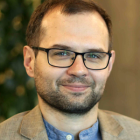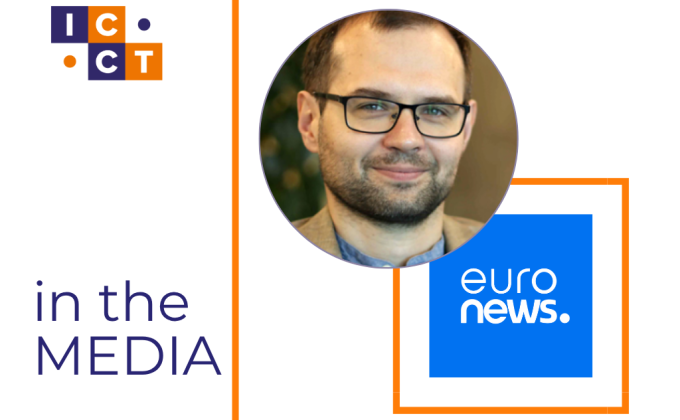ICCT’s Senior Research Fellow Kacper Rekawek sat down with Eric Skare of the University of Oslo and author of “Palestinian Islamic Jihad: Islamist Writings on Resistance and Religion” to discuss the group in the context of the current Israel-Palestine conflict.
Kacper Rekawek (KR): Erik, thanks for speaking with us. You are THE expert on the Palestinian Islamic Jihad (PIJ), a little-known terrorist group mainly operating out of the Gaza Strip and the West Bank. How is it possible that there is space for another radical Islamist outfit when Hamas is supposedly the all-controlling entity in Gaza?
Eric Skare (ES): Thank you for having me. First of all, we have to understand why PIJ was founded in 1981 and has been engaged in armed struggle from 1984 onwards. PIJ targeted Israelis five years before Hamas did the same in 1989. In those five years, violence was what distinguished them from the Palestinian Muslim Brotherhood, the forerunner of Hamas.
I think it's very important to understand that PIJ was always a historical product of a very specific stage in Palestinian history because the fact was that if you were a Palestinian in the in Gaza Strip in the 1980s, and you wanted to carry out or participate in the armed struggle against the Israeli occupation, there was no viable organisational alternatives for you to join. You technically had the Palestinian Liberation Organization (PLO) and its factions that were politically and ideologically or militarily irrelevant in the Gaza Strip in the 1980s, particularly after the evacuation from Beirut in 1982 to Tunisia. More importantly, the founding fathers of the PIJ were also fed up with what they perceived as the compromises of the PLO. For many of them, the point of no return was the adoption of the 10-point programme of the PLO in 1974 when it opened up to the possibility of using other means, including violence, to liberate the occupied Palestinian territories, opened up for the possibility of negotiating with the State of Israel, and opened up for the possibility for an only partial liberation of historical Palestinian land. This was in many respects the prelude to the Oslo Agreement in the 1990s.
At this point, the proto PIJ leaders ask the very Leninist question of “what is to be done?” Still, violence was extremely controversial in Gaza at the time, but they argued that the Islamic movement should not just participate, but it should lead the armed struggle. That was not the view of the Muslim Brotherhood, the forerunner of Hamas, in Gaza then, and this led to altercations and fistfights in the mosques between the proponents of the two views. Things, of course, changed once Hamas emerged and started its violence, and its relations with the PIJ become more cordial with the two organisations signing the Charter of Brotherhood and Cooperation in 1992, which formally ended the dispute between the two, although competition between Hamas and PIJ has been there since.
KR: It is all in the name, isn’t it? Palestinian Islamic Jihad – that implies that this would be the more radical faction?
ES: Yes, of course, PIJ sounds far scarier than Islamic resistance movement (Hamas). Nonetheless, the majority of PIJ leaders were, and are, former secular nationalist militants: members of Fatah, the early members of the Popular Front for the Liberation of Palestine (PFLP), the PLO, early members even of the Democratic Front for the Liberation of Palestine (DFLP). Although they were swayed by the religious wave in the region, from the 1970s, and particularly with the Iranian Revolution in 1979, they kept much of the secular analysis of the conflict. What mattered to them was not creedal purity, they didn't care about the correct political behaviour, what mattered for PIJ was armed struggle against Israel.
PIJ did, as such, not bother upholding community values (hisba) or engage in proselytization the way Hamas did. PIJ did not care what clothes you are wearing, whether unmarried couples held hands in the Gaza Strip. That was quite different from Hamas which for example, firebombed stores selling alcohol or protested against cinemas in Gaza. So, yes, despite the name, in the Palestinian streets, PIJ is perceived as a moderate player by Palestinians. And PIJ never had that kind of infighting with Hamas or Fatah as you saw in 2007, etc. PIJ focus very much on factional unity against Israel and on regional creedal unity against Western colonialism. It wants to keep Palestine outside of the sectarianism in the Middle East, for example, by declaring neutrality over Syria, Yemen, and Iraq.
Moreover, PIJ has never had the ambition of being a mass movement, right? It has instead perceived its own role as being an armed vanguard in the struggle. When I interviewed PIJ leader Anwar Abu Taha he noted that the difference between Hamas and PIJ is that Hamas is a political movement engaging in the military field, while PIJ is a military movement engaging in the political field.
KR: So PIJ is apolitical whereas Hamas is not?
ES: Not necessarily. When you read the political theory of Hamas, it is obvious that it envisions an Islamic, yet democratic, state enforcing, protecting, and preserving perceived Islamic values from the top down. PIJ, on the other hand, has always been far more suspicious of the state which will always turn, in their view, despotic. Their solution? A weak state apparatus kept in check by a viable civic society. Legislation, justice, and education, mentioning some, would thus be the responsibility of the latter.
PIJ wants politics, but once you have a free Palestinian state. They were against electoral participation in 1996 under Oslo and were critical of Hamas for participating in those in 2006. They said, “well, in the 1990s we had one camp of resistance with PIJ and Hamas together, and we had the forces of compromise to which the latter now also belongs.” Bear in mind, however, this was not a religiously based argument, but rather based on real political considerations and also the democratic deficiencies of the Palestinian National Authority. In 2018, PIJ released a document of principles and yes, it says that only jihad can liberate Palestine, and jihad is a duty for every Muslim, but it is also based on an understanding of international law and rights and precedents made by other resistance movements, whether in Vietnam or Algeria. It is not based on Quranic exegesis.
KR: So in this sense PIJ are anti-colonial?
ES: Yes, they see themselves as resisting colonialism. They explicitly call Israel a colonial settler entity. Israel is only the extended arm of Western colonial interests in order to preserve Western economic, political and military dominance, not only in the Islamic world, but in the entire Global South. A two-state solution, then, is an oxymoron for the movement as it equals the continued subjugation and dependency not just to the Palestinians, or the Muslims, but the entire global south. Israel thus has to be abolished in order to obtain true independence for the entire global south. That said, they do not envision the creation of a Caliphate and operate with a clear territorial definition of Palestine as PIJ is a Palestinian nationalist movement.
KR: But the name implies radicalism, fanaticism even…
ES: Radical? Sure, in the sense that it completely refuses any negotiations with the state of Israel. It does not condone any peace process. It is only armed struggle that can liberate not just the occupied Palestinian territories, not just Gaza or the West Bank, but the entire historical Palestine from the river to the sea. PIJ is also not a secular movement. For example, the abolition of Israel will not just commence the Islamization of Palestine, but also Islam’s global victory. And, as such, PIJ pretty much turned Hamas’ logic on its head. Instead of Islamization for liberation as Hamas stresses, PIJ seeks liberation of Islamization. Still, PIJ does not interpret religion to decide strategy. On the contrary, it takes a strategic choice and religion is only subsequently interpreted to legitimize that strategy.
KR: For years, the PIJ has been described as an Iranian proxy or a puppet. What does this look like in reality?
ES: The first people who describe them that way was the Palestinian Muslim Brotherhood - “Shias in disguise,” “Iranian lap dogs,” etc., which tried to slander an annoying competitor in Gaza during the great dispute about armed struggle and the Palestinian Islamic movement’s role. And yes, PIJ view the Iranian Revolution as a huge source of inspiration, as it was one of the greatest examples of a people, and they were the people dealing a blow to Western imperialism with one of the greatest allies of Israel -the US - in the Middle East, but PIJ is not, and has never been, a Khomeinist movement.
KR: How was the link between PIJ and Iran made and how did this evolve?
ES: The leadership of PIJ was imprisoned from the mid-1980s and then were deported to Lebanon by the end of the 1980s. It was in Lebanon that they had meetings with Iranian officials in the Iranian embassy in Beirut. PIJ started receiving training in the camps of Hezbollah, and funding and weaponry from Iran. Hamas jumped on that train later, particularly with the deportation of 415 Palestinian Islamists, mostly from Hamas to the Lebanese Marj al-Zuhur in 1992. PIJ’s relationship with Iran has always made it be portrayed as an Iranian proxy.
PIJ has always been very, very careful and very cautious that Iran does not infringe its own autonomy, about its own organisational independence. When PIJ suffered financial turmoil in the mid-1990s, the PIJ leadership even discussed borrowing $250,000 and $500,000 from Hamas out of fear that PIJ members would succumb to Iranian pressure due to the economic difficulties and because Iran threatened to intervene because of the lack of financial control in the movement.
Moreover, there was a fallout between PIJ and Iran in 2015 because the latter demanded an end to the former’s neutrality in the Syrian civil war. PIJ refused, and that obviously put a strain on the relationship. Nonetheless, Iran is their main sponsor and PIJ has grown de facto dependent on Iranian aid given that it has been unable to diversify its sources of income, which necessarily limits PIJ’s political maneuverability. Iran does not, however, control it as such. Moreover, PIJ is also of limited use to Iran as it views the Palestinian-Israeli conflict as bound within the Palestinian territory. It's not an international organisation which has an interest in targeting international targets. That's different from Hezbollah, for example, who have targeted a Jewish community center in Argentina in 1994, or attacked a bus with Israeli tourists in Bulgaria in 2012.
KR: PIJ has lived under Hamas rule in Gaza for the last 16 years. What kind of an experience has this been for them?
ES: First of all, there were more or less genuine attempts to merge the two organisations throughout the 1990s, but it never happened, partly, because PIJ viewed Hamas as a late-comer to the Intifada who was harvesting the fruits of PIJ’s military efforts since 1984. At the same time, Hamas has always been arrogant in the way that it considered PIJ a splinter group that should be reunited with its mother organization. So they have coexisted but competition has persisted.
In 2004, for example, a tape was leaked showing Hamas’ shura council member Fathi Hamad slandering PIJ calling them Shias, agents of Hezbollah, of Iran, etc. and slamming PIJ for attempting to outmuscle Hamas. Hamad even accused them of attempting to dress up Hamas terrorist attacks as their own to boost its own standing. The tape was symptomatic of the annoyance in Hamas that PIJ was presented as equally important in the press during the Second Intifada although Hamas was the far bigger organization.
This competition, of course, continued after 2007 when Hamas took over Gaza. Hamas has had to walk a far more delicate line between maintaining its ethos (the ethos of being a resistance movement), and armed resistance movement, where the majority of this legitimacy came from, and now also having to be a responsible governing actor. Ismail Haniya, for example, asked the other Palestinian armed factions, including the PIJ, already in 2007 not to send rockets into Israel because Hamas knew it would mean closed border crossings with no medicine, no fuel, no building material, etc. coming in via Israel.
This was definitely a win-win situation for PIJ. While Hamas claimed it sought political power to protect the resistance, many Palestinians began perceiving Hamas as a movement using the resistance to protect political power. At the same time, the PIJ, which was unencumbered by the inconvenient responsibility of governance, could continue to emphasise the need for an armed struggle, not just for ending the siege of Gaza but to liberate the whole of Palestine. So while Hamas had to moderate itself, the Islamic Jihad could portray itself as the continued principal defenders of Palestinian rights. PIJ was very happy to fill the void left by Hamas in the armed struggle from Gaza. That schism led to clashes between the two, particularly in the 2007-13 period.
Hamas broke with Syria in 2012, which meant that Iran cut much of Hamas’s funding and redirected its funding to the PIJ. So from 2011 to 2014, you see PIJ grow bigger - it grows stronger, it grows more professional with more advanced weaponry. PIJ also saw a new wave of members from Hamas and Fatah because of the infighting in 2007. In 2014, after another round of fighting with Israel, Egypt negotiated a ceasefire without involving Hamas in the negotiations. That was a huge source of annoyance for Hamas, a complete sidelining of the supposed rulers of Gaza which led to more tensions.
Finally, in August 2022, PIJ had grown to such an extent that it could wage a solo war against Israel. So, I think that the last 16 years have been incredibly kind to Islamic Jihad, it has benefited vastly from the governance of Hamas as it has filled the void.
KR: So what happens to PIJ now, in the light of 7 October attacks on Israel?
ES: Many people now talk about the potential destruction of Hamas. Now, I would be more concerned about the future of the PIJ because we now are most likely seeing Hamas returning to its roots as an underground clandestine movement, but also falling back on the social infrastructure it has effectively been constructing in Gaza since the 1970s. At the same time, it is now fully invested in fighting Israel and thus, its new posture undermines that of the PIJ. No longer is PIJ the only faction waging war on Israel.
Because PIJ has fewer strings to play on than Hamas – which has its political wing and its social services – we know that PIJ traditionally is caught in a state of asphyxiation in periods of heavy Israeli counterinsurgency. This has happened before. During the 1990s when most of its militants were killed, or they were imprisoned, the activity of PIJ was almost non-existent. Only the Second Intifada allowed for their resurgence. Currently, a similar dynamic on the ground might be developing. PIJ is also targeted by Israel, and Islamic Jihad could be hit far harder than Hamas by this war.
KR: What is the situation on the ground right now for PIJ?
ES: When we read the interviews with PIJ and its militants, these are post-fact statements, there's no smoking gun connecting PIJ to the planning of these attacks. They joined the attacks shortly after the fighting erupted and according to PIJ, Hamas informed them about the attack a couple of hours before it started. As a consequence, they immediately joined and also sent rockets. They have approximately 30 hostages in Gaza if reports are correct.
Publicly, after the 7 October attacks, the politicians of the PIJ have given full support to Hamas. This is not really a surprise when you consider that the PIJ is about the struggle, the only thing that can liberate Palestine in their view, so it wants the other factions to join the fighting. Yes, they view the attacks positively. Moreover, it is now obvious that there is coordination, not just between Hamas and PIJ, but also Hezbollah in Iran about what’s going to happen. There are reports of PIJ participating in the fighting against the ground against Israeli ground forces and they also inflicted casualties on the Israeli forces.
KR: Thank you for speaking with us Erik.
ES: Thanks for having me.
Photocredit: Anas-Mohammed/Shutterstock






